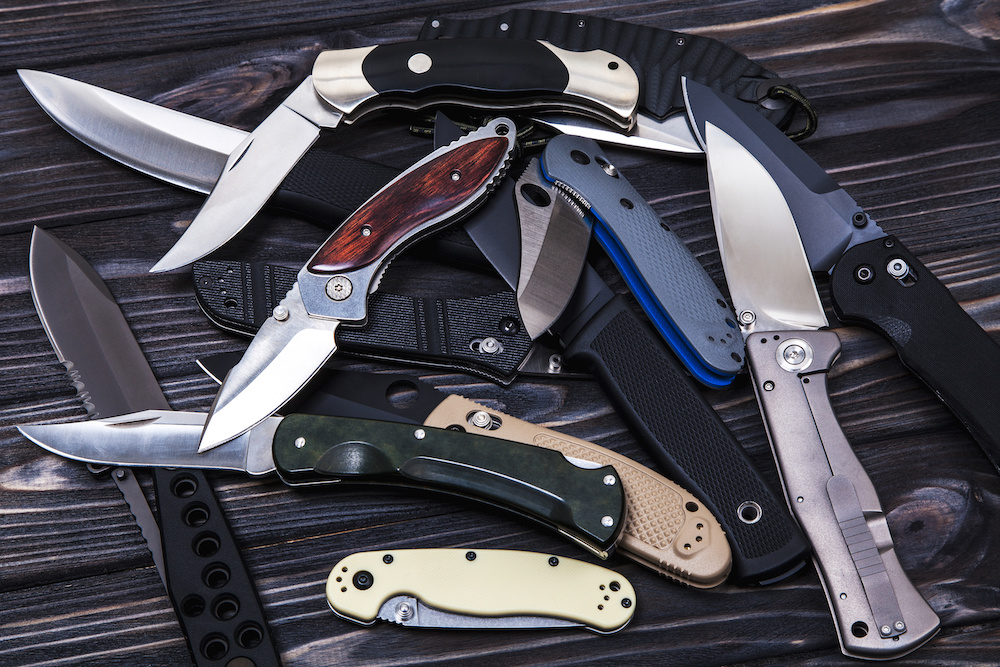Signup for our monthly newsletter and get your FREE "Tactical Gear" Guide
How to Attach a Knife to a Tactical Vest: The Different Gear Attachment Options You Can Use
- Home
- Tactical Knife Advice
- How to Attach a Knife to a Tactical Vest

This site contains affiliate links to products. We may receive a commission for purchases made through these links.
How you carry your knife on the battlefield can sometimes mean the difference between succeeding and failing in your mission.
Failing because of a nasty cut or stab wound caused by none other than, yes, you guessed it: your own carelessness.
That’s why it’s important to know how to attach a knife to a tactical vest.
This way, you can traverse different environments and handle difficult conditions without the threat of accidental self-stabbing.
Knives can come in handy in many ways, whether in the office, the kitchen, the field, or the great outdoors.
In the training grounds and battlegrounds, they are essential tools for self-defense.
But how can you use a knife to defend yourself from attackers when you don’t even know the first thing about preventing the knife from harming you?
The key is in safe carrying. Today, we will discuss how you can do just that by utilizing the knife storage features of your tactical vest and other gear.
We will also cover the correct uses of a tactical knife to help you use your blade to its full potential if and when you need to pull it out.
Table of Contents
What Is the Purpose of a Tactical Knife?
What’s the Right Knife for You?
How to Attach a Knife to a Tactical Vest
What’s a Tactical Knife?
The market is saturated with different kinds of blades suited for various purposes.
Accordingly, there are specific factors that determine a blade’s purpose.
For instance, machetes and other longer blades are ideal for clearing a path through dense vegetation. They’re difficult or almost impossible to conceal.
Short- to medium blades, on the other hand, are excellent for every use and have a wider range of applications.
In particular, the smaller varieties are ideal for concealed carrying.
Tactical knives are typically made of high-grade metals that provide them with the robustness to endure different types of tough applications, especially law-enforcement and military applications.
High-tensile strength materials are used in these knives’ construction, making them easy to carry and ideal for tactical situations.
They’re a piece of equipment people choose to carry with them once they leave the safety of their houses.
What Is the Purpose of a Tactical Knife?
A tactical knife is used mainly by members of the military, law enforcement, and fire safety department.
However, many civilians and enthusiasts have included them in their emergency kits since they first became available commercially.
These knives’ combination of durability, versatility, and material endurance has made them a go-to piece for many.
They are especially useful to outdoorspeople and camping enthusiasts who may need to use the blades to defend themselves against wild animals and mark their locations.
That’s not even half of it when you count these blades’ newer models.
In the newer releases, you get features like magnesium flints, Rambo-style inner stitching, whistles, window breaker tip, and LED lights.
So, it isn’t hard to grasp why they are so popular with everyone.
This feature-rich blade can be kept at home or in the car for emergencies, especially when your life depends on it.
The fact that having this knife can possibly mean the difference between life and death is a good reason to acquire it.
When you own this knife, it’s best to carry it with you. That way, you can easily pull it out when the situation calls for it.

What’s the Right Knife for You?
With the hundreds of available tactical knives on the market, it isn’t easy to decide the best one for you.
When choosing a tactical knife, your daily habits and overall requirements should be your main considerations.
Public safety jobs tend to call for a different brand of a tactical knife than outdoor activities, though there are knives that can work equally well in both scenarios.
Consider factors like what a typical day involves, especially concerning your movement, and you should be able to figure out exactly what kind of tactical knife suits you.
If you’re particular about how you carry a knife, size should be a major consideration.
Your options typically range from models with ones that have folding blades and those that have fixed, non-moving blades.
Folding tactical knives have the edge for convenience, as they occupy less carrying space.
These blades require manual unfolding or feature a spring mechanism for automatic unfolding.
However, their construction design tends to make them heavier than their fixed blade counterparts.
They are also more prone to fail at some point because of their moving parts.
On the other hand, tactical knives that feature non-moving blades are heavier-duty options ideal for public safety and outdoor applications.
These models are more robust and multipurpose. Not to mention, they are not likely to fail you any time soon, if at all.
That said, their bulkier and heavier structure doesn’t exactly lend to effortless everyday use.
How to Attach a Knife to a Tactical Vest
A tactical vest features different types of attachments for knives and other gear you need to access quickly on the battlefield.
Here are the best ones for your blades:
MOLLE Knife Sheath
The MOLLE knife sheath lets you store your blade safely and securely while working, hiking, or hunting.
The sheath has dual webbing straps with snap closures that fasten your knife securely inside a hard-blade insert measuring seven inches.
Sheath Adapter
Using a sheath adapter, you can attach your go-to knife with a sheath anywhere on your tactical backpack, MOLLE vest, bag, or belt.
You just slide it through your knife sheath, with the straps facing your way and the knife facing the opposite direction.
You then attach the straps to the vest.
Tek-Lok Clip
This clip should snap securely on your tactical vest and belts.
It is easy to detach and can be sewn, riveted, and even screwed on.
Plus, it’s compatible with MOLLE setups.
MOLLE Clips
You can attach pouches to MOLLE straps using MOLLE clips.
They can also be used for mounting a Kydex holster to any MOLLE gear, vests included.
For MOLLE-to-MOLLE attachments, these clips have got you covered.
They even allow you to customize attachments and pouches as you please.
How Do You Carry a Tactical Knife?
It’s one thing to carry a knife on your vest; we’ve already discussed that.
What if you want to carry your blade elsewhere but still want to keep it on you for easy access? Where do you keep it?
That’s easy; your clothes. Depending on what you’re wearing, blade carrying can be a simple, straightforward affair.
Tactical knives usually come with belt attachments and blade covers that you can fit on the inside of your jacket or leave hanging on your shorts and trousers.
Opt for a folding blade if concealment is your top priority.
It should be able to fit in your bags, purses, and smaller pockets.
The Need for a Tactical Knife
With how the world is today, we must learn to expect the unexpected.
Part of doing so is to acquire effective items for self-defense, such as a tactical blade.
Tactical knives don’t only function for self-defense, but they also help you perform everyday repair tasks at home or in the office.
They’re equally great for outdoor applications and public safety professions, especially when you know how to attach a knife to a tactical vest and other gear correctly.
A tactical blade is a tool that can help you in many different ways.
Choose the right one for your needs and use it and carry it correctly to unleash its full potential.
Ideally, have one stored in the car and another in your house; you never know when a situation would call for a tactical blade to save the day!
